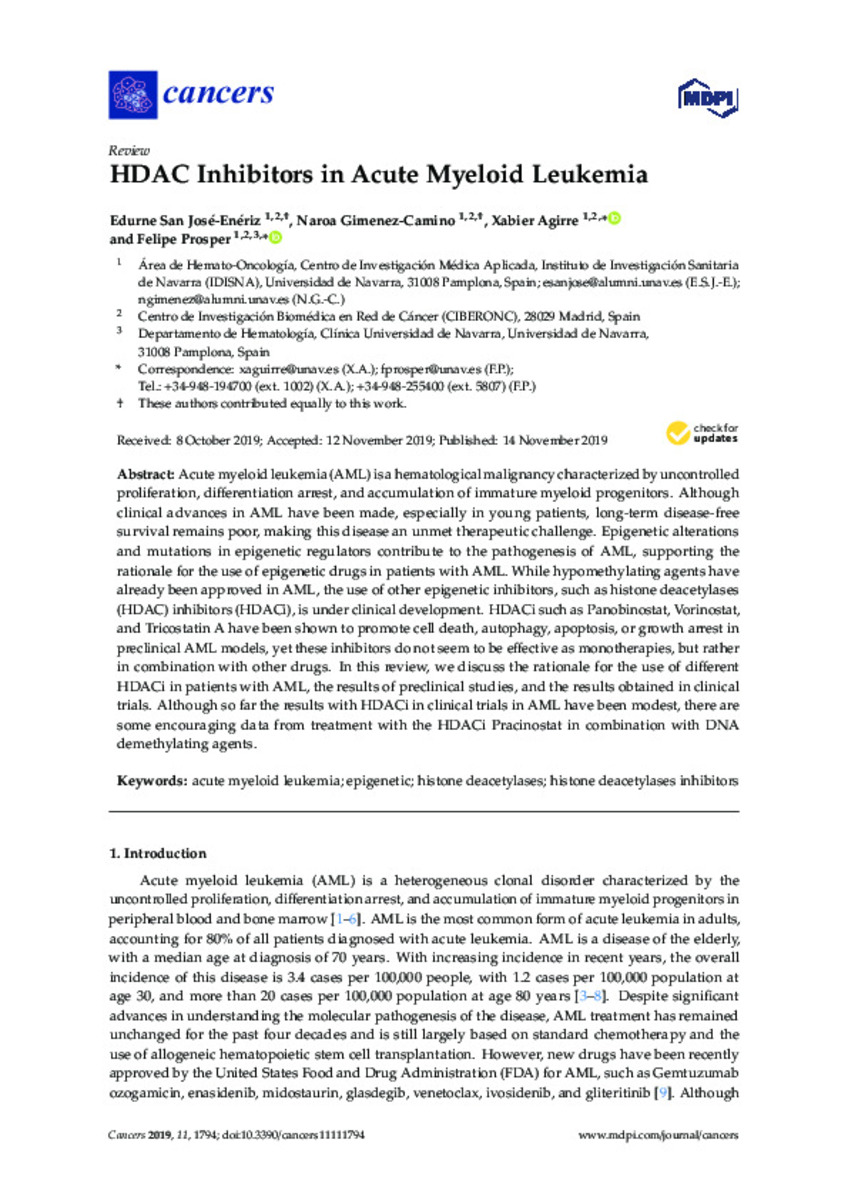Full metadata record
| DC Field | Value | Language |
|---|---|---|
| dc.creator | San-Jose-Eneriz, E. (Edurne) | - |
| dc.creator | Gimenez-Camino, N. (Naroa) | - |
| dc.creator | Aguirre-Ena, X. (Xabier) | - |
| dc.creator | Prosper-Cardoso, F. (Felipe) | - |
| dc.date.accessioned | 2021-11-09T10:55:38Z | - |
| dc.date.available | 2021-11-09T10:55:38Z | - |
| dc.date.issued | 2019 | - |
| dc.identifier.citation | San-Jose, E. (Edurne); Gimenez-Camino, N. (Naroa); Agirre-Ena, X. (Xabier); et al. "HDAC inhibitors in acute myeloid leukemia". Cancers. 11 (11), 2019, 1794 | es_ES |
| dc.identifier.issn | 2072-6694 | - |
| dc.identifier.uri | https://hdl.handle.net/10171/62375 | - |
| dc.description.abstract | Acute myeloid leukemia (AML) is a hematological malignancy characterized by uncontrolled proliferation, differentiation arrest, and accumulation of immature myeloid progenitors. Although clinical advances in AML have been made, especially in young patients, long-term disease-free survival remains poor, making this disease an unmet therapeutic challenge. Epigenetic alterations and mutations in epigenetic regulators contribute to the pathogenesis of AML, supporting the rationale for the use of epigenetic drugs in patients with AML. While hypomethylating agents have already been approved in AML, the use of other epigenetic inhibitors, such as histone deacetylases (HDAC) inhibitors (HDACi), is under clinical development. HDACi such as Panobinostat, Vorinostat, and Tricostatin A have been shown to promote cell death, autophagy, apoptosis, or growth arrest in preclinical AML models, yet these inhibitors do not seem to be effective as monotherapies, but rather in combination with other drugs. In this review, we discuss the rationale for the use of different HDACi in patients with AML, the results of preclinical studies, and the results obtained in clinical trials. Although so far the results with HDACi in clinical trials in AML have been modest, there are some encouraging data from treatment with the HDACi Pracinostat in combination with DNA demethylating agents. | es_ES |
| dc.description.sponsorship | This study was financed by Instituto de Salud Carlos III and co-financed by FEDER (Fondo Europeo de Desarrollo Regional) (RTICC (Red Temática de Investigación Cooperativa en Cáncer) RD12/0036/0068, PI16/02024, PI17/00701, Centro de Investigación Biomédica en Red Cáncer (CIBERONC) CB16/12/00489, ERANET-TRANSCAN-2 (Aligning national/regional translational cancer research programmes and activities) EPICA (Dual EPigenetic targeting and Immunotherapy to fight against Cancer) AC16/00041) and Gobierno de Navarra Salud and cofinanced by FEDER (40/2016, Proyecto DIANA). | es_ES |
| dc.language.iso | eng | es_ES |
| dc.publisher | MDPI AG | es_ES |
| dc.rights | info:eu-repo/semantics/openAccess | es_ES |
| dc.subject | Acute myeloid leukemia | es_ES |
| dc.subject | Epigenetic | es_ES |
| dc.subject | Histone deacetylases | es_ES |
| dc.subject | Histone deacetylases inhibitors | es_ES |
| dc.title | HDAC inhibitors in acute myeloid leukemia | es_ES |
| dc.type | info:eu-repo/semantics/article | es_ES |
| dc.description.note | This article is an open access article distributed under the terms and conditions of the Creative Commons Attribution (CC BY) license (http://creativecommons.org/licenses/by/4.0/). | es_ES |
| dc.identifier.doi | 10.3390/cancers11111794 | - |
| dadun.citation.number | 11 | es_ES |
| dadun.citation.publicationName | Cancers | es_ES |
| dadun.citation.startingPage | 1794 | es_ES |
| dadun.citation.volume | 11 | es_ES |
Files in This Item:
Statistics and impact
Items in Dadun are protected by copyright, with all rights reserved, unless otherwise indicated.






